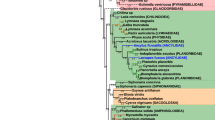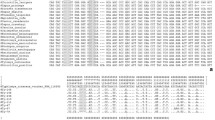Abstract
The phylogenetic relationships among 23 individuals representing 14 species of underground hystricognath rodents of the genus Ctenomys were studied by analyzing variation of complete cytochrome b gene sequences. Maximum parsimony, neighbor joining, and maximum likelihood analyses were performed, using the octodontine genera Octodon and Tympanoctomys as outgroups. Our analyses support previous studies based on chromosomes and skull morphology that suggested a clade comprised of Argentinean and Uruguayan populations of C. rionegrensis. This clade is closely related to one comprised of C. flamarioni and the C. mendocinus species complex. Our analyses provide evidence that the symmetric sperm morph, which is common to other South American hystricognath rodents, is the plesiomorphic character state in Ctenomys and in Hystricognathi. Our analyses do not support the hypothesis that the sperm morphs define two major lineages of tuco-tuco species, because species with asymmetric sperm are diphyletic on the basis of cytochrome b sequences, and this morphology appears to have evolved twice in Ctenomys.
Similar content being viewed by others
LITERATURE CITED
Altuna, C. A., Ubilla, M., and Lessa, E. P. (1985). Estado actual del conocimiento de Ctenomys rionegrensis Langguth y Abella, 1970 (Rodentia, Octodontidae). Actas Jornadas de Zoología del Uruguay 1: 8–9.
Altuna, C. A., Novello, A. F., and Lessa, E. P. (1986). Notas sobre la morfología espermática de Ctenomys rionegrensis (Rodentia, Octodontidae) del Uruguay. Brenesia 24: 397–401.
Anderson, S., Yates, T. L., and Cook, J. A. (1987). Notes on Bolivian mammals 4: The genus Ctenomys (Rodentia, Ctenomyidae) in the eastern lowlands. Am. Mus. Novitates 2891: 1–20.
Balbontin, J., Reig, S., and Moreno, S. (1996). Evolutionary relationships of Ctenomys (Rodentia: Octodontidae) from Argentina, based on penis morphology. Acta Theriol. 41: 237–253.
Beckman, K. B., Smith, M. F., and Orrego, C. (1993). Purification of mitochondrial DNA with Wizard minipreps DNA purification system. Promega Notes 43: 10–13.
Berrios, M., Flechon, J. E., and Barros, C. (1978). Ultrastructure of Octodon degus spermatozoon with special reference to the acrosome. Am. J. Anat. 151: 39–54.
Bremer, K. (1988). The limits of the amino-acid sequence data in angiosperm phylogenetic reconstruction. Evolution 42: 795–803.
Cook, J. A., and Lessa, E. P. (1998). Are rates of diversification in subterranean South American tuco-tucos (genus Ctenomys, Rodentia: Octodontidae) unusually high? Evolution 52: 1521–1527.
Cook, J. A., and Yates, T. L. (1994). Systematic relationships of the tuco-tucos, genus Ctenomys (Rodentia: Octodontidae). J. Mammal. 75: 583–599.
Cook, J. A., Anderson, S., and Yates, T. L. (1990). Notes on Bolivian mammals 6: The genus Ctenomys (Rodentia: Ctenomyidae) in the highlands. Am. Mus. Novitates 2980: 1–27.
da Silva, M. N., and Patton, J. L. (1993). Amazonian phylogeography: mtDNA sequence variation in arboreal echimyid rodents (Caviomorpha). Mol. Phyl. Evol. 2: 243–255.
D'Elía, G., Lessa, E. P., and Cook, J. A. (1998). Geographic structure, gene flow, and maintenance of melanism in Ctenomys rionegrensis (Rodentia: Octodontidae). Z. Säugetierk. 63: 285–296.
Feito, R., and Barros, C. (1982). Ultrastructure of the head of Ctenomys maulinus spermatozoon with special reference to the nucleus. Gamete Res. 5: 317–321.
Feito, R., and Gallardo, M. (1976). Notes on the sperm morphology of Ctenomys maulinus (Rodentia, Octodontidae). Experientia 32: 735–736.
Feito, R., and Gallardo, M. (1982). Sperm morphology of the Chilean species of Ctenomys (Octodontidae). J. Mammal. 63: 658–661.
Felsenstein, J. (1993). PHYLIP (Phylogeny Inference Package), Version 3.5c, University of Washington, Seattle.
Freitas, T. R. O. (1994). Geographical variation of heterochromatin in Ctenomys flamarioni (Rodentia-Octodontidae) and its cytogenetic relationships with other species of the genus. Cytogenet. Cell Genet. 67: 193–198.
Freitas, T. R. O., and Lessa, E. P. (1984). Cytogenetics and morphology of Ctenomys torquatus (Rodentia: Octodontidae). J. Mammal. 65: 637–642.
Gardner, S. L. (1991). Phyletic coevolution between subterranean rodents of the genus Ctenomys (Rodentia: Hystricognathi) and nematodes of the genus Paraspidodera (Heterakoidea: Aspidoderidae) in the neotropics: Temporal and evolutionary implications. Zool. J. Linn. Soc. 102: 169–201.
Giménez, M. D., Contreras, J. R., and Bidau, C. J. (1997). Chromosomal variation in Ctenomys pilarensis, a recently described species from eastern Paraguay (Rodentia, Ctenomyidae). Mammalia 61: 385–398.
Hillis, D. M. (1991). Discriminating between phylogenetic signal and random noise in DNA sequences. In: Phylogenetic Analysis of DNA Sequences, M. M. Miyamoto and J. Cracraft, eds., pp. 278–294, Oxford University Press, Oxford.
Hillis, D. M., and Huelsenbeck, J. P. (1992). Signal, noise, and reliability in molecular phylogenetic analyses. J. Hered. 83: 189–195.
Irwin, D. M., Kocher, T. D., and Wilson, A. C. (1991). Evolution of the cytochrome b gene of mammals. J. Mol. Evol. 32: 128–144.
Kelt, D. A., and Gallardo, M. H. (1994). A new species of tuco-tuco, genus Ctenomys (Rodentia: Ctenomyidae) from Patagonian Chile. J. Mammal. 75: 338–348.
Kiblisky, P., Brum-Zorrilla, N., Pérez, G., and Saez, F. A. (1977). Variabilidad cromosómica entre diversas poblaciones uruguayas del roedor cavador del género Ctenomys (Rodentia-Octodontidae). Mendeliana 2: 85–93.
Kishino, H., and Hasegawa, M. (1989). Evaluation of the maximum likelihood estimates of the evolutionary tree topologies from DNA sequence data, and the branching order in Hominoidea. J. Mol. Evol. 29: 170–179.
Kumar, S., Tamura, K., and Nei, M. (1993). MEGA: Molecular Evolutionary Genetics Analysis, Version 1.01, Pennsylvania State University, University Park.
Langguth, A., and Abella, A. (1970). Las especies uruguayas del género Ctenomys. Com. Zool. Mus. Hist. Nat. Montevideo 10: 1–27.
Lara, M. C., Patton, J. L., and da Silva, M. N. (1996). The simultaneous diversification of South American echimyid rodents (Hystricognathi) based on complete cytochrome b sequences. Mol. Phyl. Evol. 5: 403–413.
Lessa, E. P., and Cook, J. A. (1998). The molecular phylogenetics of tuco-tucos (genus Ctenomys, Rodentia: Octodontidae) suggests an early burst of speciation. Mol. Phyl. Evol. 9: 88–99.
Ma, D. P., Zharkikh, A., Graur, D., VandeBerg, J., and Li, W. H. (1993). Structure and evolution of opossum, guinea pig, and porcupine cytochrome b genes. J. Mol. Evol. 36: 327–334.
Maniatis, T., Fritsch, E. F., and Sambrook, J. (1992). Molecular Cloning: A Laboratory Manual, Cold Spring Harbor Laboratory, Cold Spring Harbor, NY.
Massarini, A. I. (1996). Análisis cromosómico de Ctenomys rionegrensis de Ibicuy (Pcia. de Entre Ríos). In: Actas de las XI Jornadas Argentinas de Mastozoologia, p. 59, San Luis.
Massarini, A. I., Barros, M. A., Ortells, M. O., and Reig, O. A. (1991). Chromosomal polymorphism and small karyotypic differentiation in a group of Ctenomys species from Central Argentina (Rodentia: Octodontidae). Genetica 83: 131–144.
Miller, S. A., Dikes, D. D., and Polesky, H. F. (1988). A simple salting out procedure for extracting DNA from human nucleated cells. Nucleic Acids Res. 16: 215.
Nei, M. (1987). Molecular Evolutionary Genetics, Columbia University Press, New York.
Novello, A. F., and Lessa, E. P. (1986). G-band homology in two karyomorphs of the Ctenomys pearsoni complex (Rodentia: Octodontidae) of neotropical fossorial rodents. Z. Säugetierk. 51: 378–380.
Ortells, M. O. (1995). Phylogenetic analysis of G-banded karyotypes among the South American subterranean rodents of the genus Ctenomys (Caviomorpha: Octodontidae), with special reference to chromosomal evolution and speciation. Biol. J. Linn. Soc. 54: 43–70.
Ortells, M. O., Contreras, J. R., and Reig, O. A. (1990). New Ctenomys karyotypes (Rodentia, Octodontidae) from north-eastern Argentina and from Paraguay confirm the extreme chromosomal multiformity of the genus. Genetica 82: 189–201.
Osgood, W. H. (1946). A new octodont rodent from the Paraguayan chaco. Fieldiana Zool. 31: 47–49.
Patton, J. L., and Smith, M. F. (1994). Paraphyly, polyphyly and the nature of species boundaries in pocket gophers (genus Thomomys). Syst. Biol. 43: 11–26.
Patton, J. L., da Silva M. N., and Malcolm, J. R. (1994). Gene genealogy and differentiation among arboreal spiny rats (Rodentia: Echimyidae) of the Amazon Basin: a test of the riverine barrier hypothesis. Evolution 48: 1314–1323.
Pearson, O. P. (1984). Taxonomy and natural history of some fossorial rodents of Patagonia, southern Argentina. J. Zool. London. 202: 225–237.
Prager, M. E., Sage, R. D., Gyllensten, U., Thomas, W. K., Hübner, R., Jones, C. S., Noble, L., Searle, J. B., and Wilson, A. C. (1993). Mitochondrial DNA sequence diversity and the colonization of Scandinavia by the house mice from East Holstein. Biol. J. Linn. Soc. 50: 85–122.
Reig, O. A. (1989). Karyotypic repatterning as one triggering factor in cases of explosive speciation. In: Evolutionary Biology of Transient Unstable Populations, A. Fontdevila, ed., pp. 246–289, Springer-Verlag, Berlin.
Reig, O. A., and Kiblisky, P. (1969). Chromosome multiformity in the genus Ctenomys (Rodentia, Octodontidae), a progress report. Chromosoma 28: 211–244.
Reig, O. A., and Quintana, C. A. (1992). Fossil ctenomyine rodents of the genus Eucelophorus (Caviomorpha: Octodontidae) from the Pliocene and early Pleistocene of Argentina. Ameghiniana 29: 363–380.
Reig, O. A., Busch, C., Ortells, M. O., and Contreras, J. R. (1990). An overview of evolution, systematics, population biology, cytogenetics, molecular biology and speciation in Ctenomys, In: Evolution of Subterranean Mammals at the Organismal and Molecular Levels, E. Nevo and O. A. Reig, eds., pp. 71–96, Wiley-Liss, New York.
Reig, O. A., Massarini, A. I., Ortells, M. O., Barros, M. A., Tiranti, S. I., and Dyzenchauz, F. J. (1992). New karyotypes and C-banding patterns of the subterranean rodents of the genus Ctenomys (Caviomorpha, Octodontidae) from Argentina. Mammalia 56: 603–623.
Rossi, M. S., Reig, O. A., and Zorzópulos, J. (1993). A major satellite DNA from the South American rodents of the genus Ctenomys: Quantitative and qualitative differences in species with different geographic distribution. Z. Säugetierk. 58: 244–251.
Rusconi, C. (1928). Dispersión geográfica de los tuco-tucos vivientes (Ctenomys) en la región Neotropical. An. Soc. Argent. Estud. Geog. GAEA 3: 235–254.
Saitou, N., and Nei, M. (1987). The neighbor-joining method: A new method for reconstructing phylogenetic trees. Mol. Biol. Evol. 4: 406–425.
Smith, M. F., and Patton, J. L. (1993). The diversification of South American murid rodents: evidence from mitochondrial DNA sequence data for the akodontine tribe. Biol. J. Linn. Soc. 50: 149–177.
Swofford, D. L. (1993). Phylogenetic Analysis Using Parsimony (PAUP), Version 3.1.1, Illinois Natural History Survey, Champaign.
Tamura, K., and Nei, M. (1993). Estimation of the number of nucleotide substitutions in the control region of mitochondrial DNA in humans and chimpanzees. Mol. Biol. Evol. 10: 512–526.
Thomas, O. (1916). Two new Argentine rodents, with a new subgenus of Ctenomys. Ann. Mag. Nat. Hist. 18: 303–306.
Villar, S., and Chiesa, A. (1996). Estudio cariológico de poblaciones polimórficas a nivel del pelaje de Ctenomys rionegrensis. In: Actas de las IV Jornadas de Zoología del Uruguay, p. 43, Montevideo.
Vitullo, A. D., and Cook, J. A. (1991). The role of sperm morphology in the evolution of tuco-tucos, Ctenomys (Rodentia, Ctenomyidae): Confirmation of results from Bolivian species. Z. Säugetierk. 56: 359–364.
Vitullo, A. D., Roldan, E. R., and Merani, M. S. (1988). On the morphology of spermatozoa of tuco-tucos, Ctenomys (Rodentia: Ctenomyidae): New data and its implications for the evolution of the genus. J. Zool. Lond. 215: 675–683.
White, M. J. (1978). Modes of Speciation, W. H. Freeman, San Francisco.
Woods, C. A. (1993). Suborder Hystricognathi. In: Mammal Species of the World, D. E. Wilson and D. M. Reeder, eds., pp. 771–806, Smithsonian Institution Press, Washington, DC.
Author information
Authors and Affiliations
Corresponding author
Rights and permissions
About this article
Cite this article
D'Elía, G., Lessa, E.P. & Cook, J.A. Molecular Phylogeny of Tuco-Tucos, Genus Ctenomys (Rodentia: Octodontidae): Evaluation of the mendocinus Species Group and the Evolution of Asymmetric Sperm. Journal of Mammalian Evolution 6, 19–38 (1999). https://doi.org/10.1023/A:1020586229342
Issue Date:
DOI: https://doi.org/10.1023/A:1020586229342




